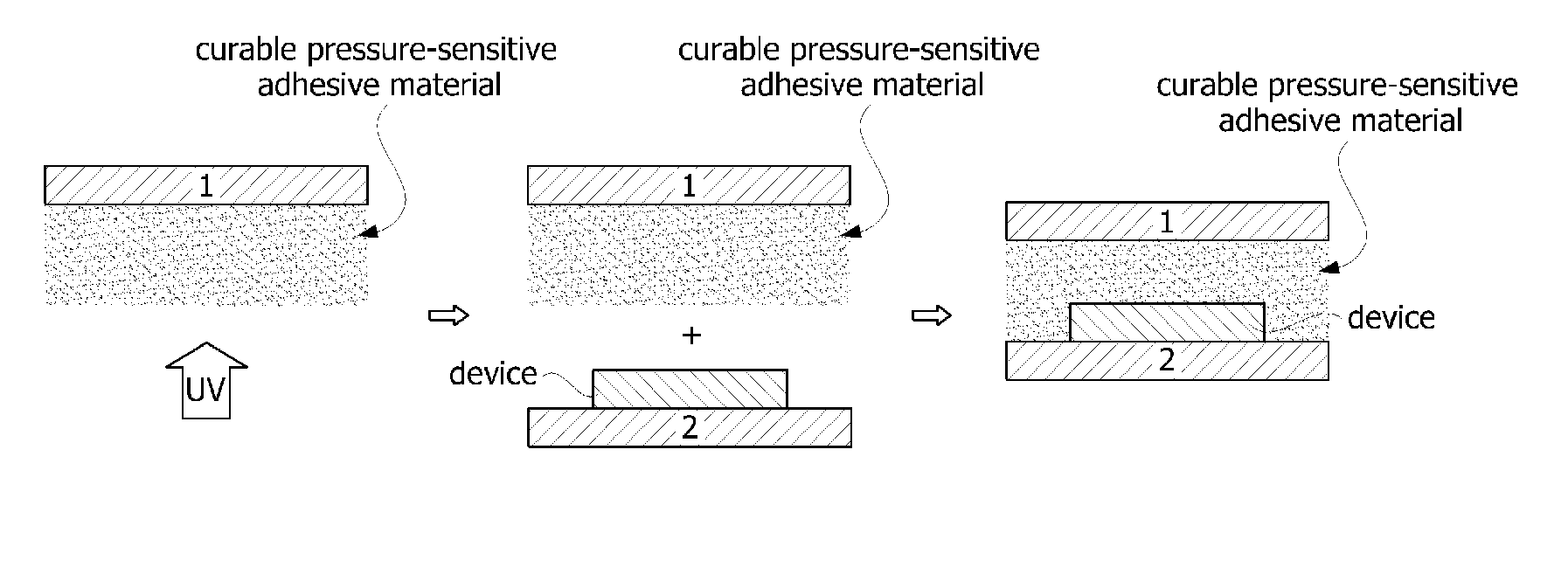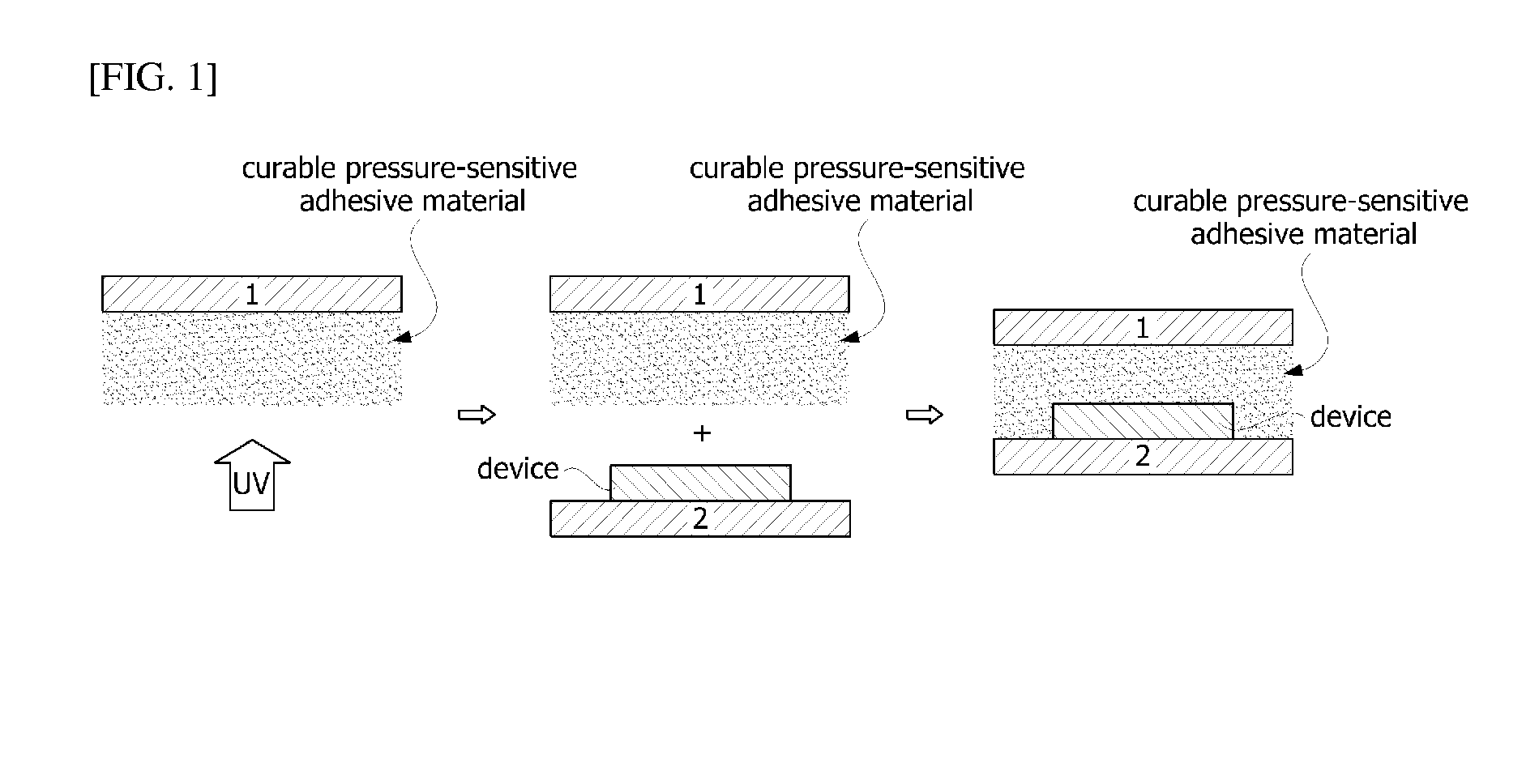Photocurable adhesive film for organic electronic device seal, organic electronic device, and method for sealing same
a technology of organic electronic devices and adhesive films, applied in the direction of film/foil adhesives, film/foil adhesives without carriers, solid-state devices, etc., can solve the problems of reducing the efficiency of heat emission, large-scale elements have limitations in edge sealing methods, and complicated processes, etc., to achieve high degree of process freedom, short time, and simple process
- Summary
- Abstract
- Description
- Claims
- Application Information
AI Technical Summary
Benefits of technology
Problems solved by technology
Method used
Image
Examples
example 1
Preparation of Curable Pressure-Sensitive Adhesive Film and OED
[0082]An acrylic polymer having a glass transition temperature of approximately −20° C. and a weight average molecular weight of 500,000 was prepared by polymerizing a pressure-sensitive adhesive containing 15 parts by weight of butyl acrylate, 40 parts by weight of methylethylacrylate, 20 parts by weight of isobornylacrylate, 15 parts by weight of methyl acrylate, and 10 parts by weight of hydroxyethylacrylate.
[0083]A coating solution was prepared to have a solid content of 20% by adding 0.2 parts by weight of an isocyanate-based crosslinking agent (xylene diisocyanate, T-39M), 5 parts by weight of a trimethylolpropane-type epoxy resin (SR-TMP, SAKAMOTO), 0.25 parts by weight of a triarylsulfonium salt-type cationic photopolymerization initiator (CPI-110A, SAN-APRO Ltd.), relative to 100 parts by weight of the acrylic polymer to the acrylic polymer, and adding ethyl acetate as a solvent.
[0084]A curable pressure-sensitiv...
experimental example 1
Measurement of Viscosity
[0090]Viscosities of the curable pressure-sensitive adhesive layers of the adhesive films according to Example 1 and Comparative Examples 1 to 4 before and after light irradiation were measured by ARES, and the results are listed in Table 1.
TABLE 1Viscosity before lightViscosity after lightirradiationirradiation(Pa · s, 25° C.)(Pa · s, 25° C.)Example 14.1 × 1051.2 × 106Comparative3.9 × 1059.8 × 105Example 1Comparative4.2 × 1057.1 × 105Example 2Comparative4.3 × 1054.3 × 105Example 3Comparative3.7 × 1052.5 × 106Example 4
experimental example 2
Evaluation of WVTR
[0091]After the curable pressure-sensitive adhesive films prepared in Example 1 and Comparative Examples 1 to 4 were heat-cured, WVTRs with respect to an area of 1 cm2 were measured using the PERMATRAN-W Model 3 / 61 produced by MOCON under conditions of a temperature of 37.8° C. and relative humidity of 100%. The results are listed in Table 2.
PUM
| Property | Measurement | Unit |
|---|---|---|
| viscosity | aaaaa | aaaaa |
| viscosity | aaaaa | aaaaa |
| temperature | aaaaa | aaaaa |
Abstract
Description
Claims
Application Information
 Login to View More
Login to View More - R&D
- Intellectual Property
- Life Sciences
- Materials
- Tech Scout
- Unparalleled Data Quality
- Higher Quality Content
- 60% Fewer Hallucinations
Browse by: Latest US Patents, China's latest patents, Technical Efficacy Thesaurus, Application Domain, Technology Topic, Popular Technical Reports.
© 2025 PatSnap. All rights reserved.Legal|Privacy policy|Modern Slavery Act Transparency Statement|Sitemap|About US| Contact US: help@patsnap.com


